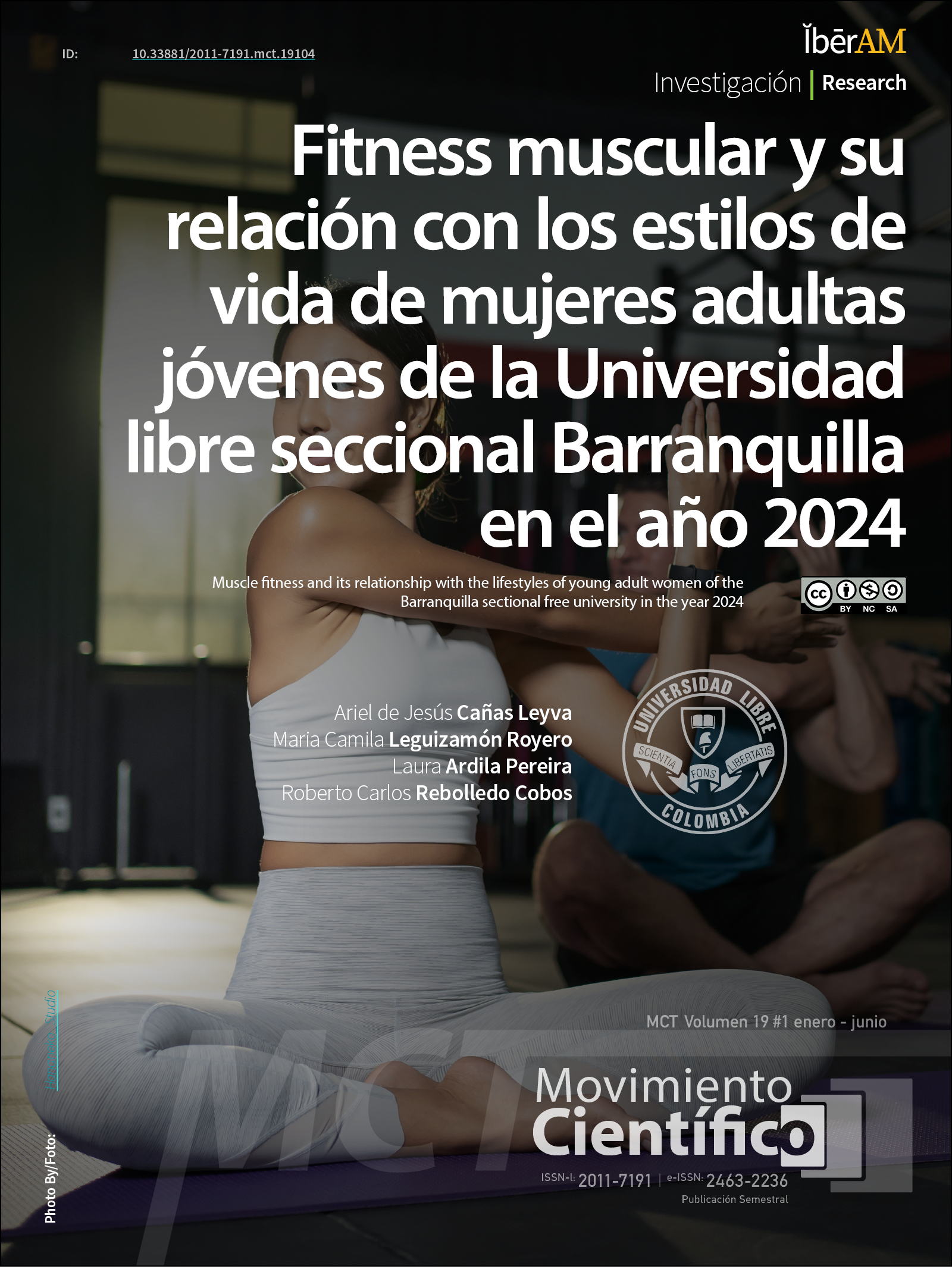Muscle fitness and its relationship with the lifestyles of young adult women of the Barranquilla sectional free university in the year 2024
Fitness muscular y su relación con los estilos de vida de mujeres adultas jóvenes de la Universidad libre seccional Barranquilla en el año 2024
Main Article Content
Introduction: Muscle fitness, specifically handgrip strength, has been identified as a key health and physical condition indicator in young women. A sedentary lifestyle and unhealthy habits can negatively impact muscle strength, increasing the risk of cardiovascular and metabolic diseases. This study analyzes the relationship between lifestyle habits and muscle fitness in young adult women from Universidad Libre Seccional Barranquilla. Methodology:
A descriptive and analytical cross-sectional study was conducted with 346 women aged 16 to 35 years. Surveys assessed emotional management, nutrition, and sleep, while anthropometric and physical activity measurements were taken. Handgrip strength was measured using a K-GRIP electronic dynamometer, and data were analyzed using SPSS 23.0, applying Chi² and ANOVA tests to determine significant associations (p<0.05). Results:
Women with higher body fat percentage (>30%) and severe sedentary behavior (12-16 hours of sitting per day) had the lowest handgrip strength levels (18.2 kg left hand in the under-18 group). In contrast, the 31-35 age group, with a moderate body fat percentage (26.14%), showed the highest handgrip strength (22.6 kg right hand and 21 kg left hand). Regular physical activity, adequate sleep, and a sense of life purpose were positively correlated with higher handgrip strength. Conclusion:
This study confirms that lifestyle choices significantly influence handgrip strength. Lack of physical activity, excess body fat, and unhealthy habits negatively impact muscle fitness, emphasizing the need for preventive strategies. These findings support the implementation of educational and intervention programs to improve the health and well-being of young women, reducing the risk of chronic diseases.
Downloads
Publication Facts
Reviewer profiles N/A
Author statements
Indexed in
-
—
- Academic society
- N/A
- Publisher
- Bogotá: Corporación Universitaria Iberoamericana
Article Details
Baudet, M., Daugareil, C., & Ferrieres, J. (2012). Cardiovascular disease prevention and life hygiene modifications. Annales de Cardiologie et d’Angeiologie, 61(2). https://doi.org/10.1016/j.ancard.2011.05.007 DOI: https://doi.org/10.1016/j.ancard.2011.05.007
Correa-Rodríguez, M., Ramírez-Vélez, R., Correa-Bautista, J. E., Castellanos-Vega, R. del P., Arias-Coronel, F., González-Ruíz, K., Carrillo, H. A., Schmidt-Riovalle, J., & González-Jiménez, E. (2018). Association of muscular fitness and body fatness with cardiometabolic risk factors: The FUPRECOL study. Nutrients, 10(11). https://doi.org/10.3390/nu10111742 DOI: https://doi.org/10.3390/nu10111742
Departamento Administrativo Nacional de Estadística. (2021). Informe panorama sociodemográfico juventud en Colombia. https://www.dane.gov.co/files/investigaciones/genero/informes/informe-panorama-sociodemografico-juventud-en-colombia.pdf
Departamento Nacional de Planeación (DNP). (2023). Objetivos de Desarrollo Sostenible (ODS). Departamento Nacional de Planeación. https://ods.dnp.gov.co/
Domínguez-Gabriel, C. M., Pacheco-Preciado, A. R., Franco-Escobar, C., Petro, J. L., & Calvo Betancur, V. D. (2020). Handgrip strength, body composition, physical activity and food consumption in workers of a higher education institution. Revista Facultad Nacional de Salud Pública, 39(2). https://doi.org/10.17533/udea.rfnsp.e342389 DOI: https://doi.org/10.17533/udea.rfnsp.e342389
Fundación Española del Corazón. (2023). La medida del perímetro abdominal es un indicador de enfermedad cardiovascular más fiable que el IMC. Fundación Española del Corazón. https://fundaciondelcorazon.com/prensa/notas-de-prensa/2264-medida-perimetro-abdominal-es-indicador-enfermedad-cardiovascular-mas-fiable-imc-.html
Gómez-Arias, R. D., Bonmati, A. N., Pereyra-Zamora, P., Rodríguez-Ospina, F. L., & Agudelo-Londoño, S. M. (2009). Mortalidad evitable y políticas en salud. Colombia, 1985-2002. Colombia Médica (Cali, Colombia), 40(4), 373–386. https://doi.org/10.25100/cm.v40i4.668 DOI: https://doi.org/10.25100/cm.v40i4.668
Pinillos-Patiño Y, Rebolledo-Cobos R, Herazo-Beltrán Y, Oviedo-Argumedo E, Guerrero Ospino M, Valencia-Fontalvo P, Cortés-Moreno G. Estilo de vida en adultos jóvenes universitarios de Barranquilla, Colombia. Diferencias según sexo y estatus socioeconómico. Retos . 2022;43:979-987. Disponible en: https://recyt.fecyt.es/index.php/retos/article/view/8072019 DOI: https://doi.org/10.47197/retos.v43i0.87335
Hirshkowitz, M., Whiton, K., Albert, S. M., Alessi, C., Bruni, O., DonCarlos, L., Hazen, N., Herman, J., Katz, E. S., Kheirandish-Gozal, L., Neubauer, D. N., O’Donnell, A. E., Ohayon, M., Peever, J., Rawding, R., Sachdeva, R. C., Setters, B., Vitiello, M. V., Ware, J. C., & Adams Hillard, P. J. (2015). National sleep foundation’s sleep time duration recommendations: Methodology and results summary. Sleep Health, 1(1). https://doi.org/10.1016/j.sleh.2014.12.010 DOI: https://doi.org/10.1016/j.sleh.2014.12.010
K-INVEST México. (2023). K-Grip: Solución avanzada para evaluación y entrenamiento muscular. K-INVEST México. https://www.kinvent.com.mx/k-grip
Martín Moreno, V., Gómez Gandoy, J. B., & Antoranz González, M. J. (2001). Medición de la grasa corporal mediante impedancia bioeléctrica, pliegues cutáneos y ecuaciones a partir de medidas antropométricas. Análisis comparativo. Revista Española de Salud Pública, 75(3), 221–230. https://scielo.isciii.es/scielo.php?script=sci_arttext&pid=S1135-57272001000300006 DOI: https://doi.org/10.1590/S1135-57272001000300006
ONS Observatorio Nacional de Salud, & INS Instituto Nacional de Salud. (2016). La enfermedad cardiovascular como principal causa de muerte en Colombia. https://www.ins.gov.co/Direcciones/ONS/Boletines/boletin_web_ONS/boletin1.html
Owen, N., Healy, G. N., Matthews, C. E., & Dunstan, D. W. (2010). Too much sitting: The population health science of sedentary behavior. Exercise and Sport Sciences Reviews, 38(3). https://doi.org/10.1097/JES.0b013e3181e373a2 DOI: https://doi.org/10.1097/JES.0b013e3181e373a2
Owens, J., Au, R., Carskadon, M., Millman, R., Wolfson, A., Braverman, P. K., Adelman, W. P., Breuner, C. C., Levine, D. A., Marcell, A. V., Murray, P. J., & O’Brien, R. F. (2014). Insufficient sleep in adolescents and young adults: An update on causes and consequences. Pediatrics, 134(3). https://doi.org/10.1542/peds.2014-1696 DOI: https://doi.org/10.1542/peds.2014-1696
Poole, D. C., Kano, Y., Koga, S., & Musch, T. I. (2021). August Krogh: Muscle capillary function and oxygen delivery. Comparative Biochemistry and Physiology -Part A: Molecular and Integrative Physiology, 253. https://doi.org/10.1016/j.cbpa.2020.110852 DOI: https://doi.org/10.1016/j.cbpa.2020.110852
Rodrigues De Lima, T., Custódio Martins, P., Henrique Guerra, P., & Augusto Santos Silva, D. (2020). Muscular fitness and cardiovascular risk factors in children and adolescents: A systematic review. Journal of Strength and Conditioning Research, 34(8). https://doi.org/10.1519/JSC.0000000000002840 DOI: https://doi.org/10.1519/JSC.0000000000002840
Sociedad, U. Y., Guillermina, N., Villavicencios, V., Merino, P., Elí, F., & Ramos, E. (2020). Volumen 12 | Número 6 | Noviembre-Diciembre. https://orcid.org/0000-0002-9177-6490
Unidas, N. (2030). La Agenda 2030 y los Objetivos de Desarrollo Sostenible: Una oportunidad para América Latina y el Caribe. www.issuu.com/publicacionescepal/stacks
Zea-Robles, A. C., León-Ariza, H. H., Botero-Rosas, D. A., Afanador-Castañeda, H. D., & Pinzón-Bravo, L. A. (2014). Factores de riesgo cardiovascular y su relación con la composición corporal en estudiantes universitarios. Revista de Salud Pública, 16(4), 505–515. https://doi.org/10.15446/rsap.v16n4.38878 DOI: https://doi.org/10.15446/rsap.v16n4.38878














